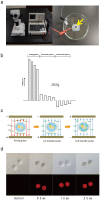Simple knockout by electroporation of engineered endonucleases into intact rat embryos
- PMID: 25269785
- PMCID: PMC4180828
- DOI: 10.1038/srep06382
Simple knockout by electroporation of engineered endonucleases into intact rat embryos
Abstract
Engineered endonucleases, such as zinc-finger nucleases (ZFNs), transcription activator-like effector nucleases (TALENs), and the clustered regularly interspaced short palindromic repeat (CRISPR)/CRISPR-associated (Cas) system, provide a powerful approach for genome editing in animals. However, the microinjection of endonucleases into embryos requires a high skill level, is time consuming, and may cause damage to embryos. Here, we demonstrate that the electroporation of endonuclease mRNAs into intact embryos can induce editing at targeted loci and efficiently produce knockout rats. It is noteworthy that the electroporation of ZFNs resulted in an embryonic survival rate (91%) and a genome-editing rate (73%) that were more than 2-fold higher than the corresponding rates from conventional microinjection. Electroporation technology provides a simple and effective method to produce knockout animals.
Conflict of interest statement
Kyoto University and NEPA GENE Co. Ltd. have applied for a patent describing this method (patent application no. 2013-209184). T.K. and T.M. are listed as inventors of the patent and will receive part of the revenue that it may generate.
Figures

References
-
- Jacob H. Functional genomics and rat models. Genome Res. 9, 1013–1016 (1999). - PubMed
-
- Aitman T. J. et al. Progress and prospects in rat genetics: a community view. Nat. Genet. 40, 516–522 (2008). - PubMed
-
- Mullins J. J., Peters J. & Ganten D. Fulminant hypertension in transgenic rats harbouring the mouse Ren-2 gene. Nature 344, 541–544 (1990). - PubMed
-
- Charreau B., Tesson L., Soulillou J. P., Pourcel C. & Anegon I. Transgenesis in rats: technical aspects and models. Transgenic Res. 5, 223–234 (1996). - PubMed
MeSH terms
Substances
LinkOut - more resources
Full Text Sources
Other Literature Sources
Research Materials

